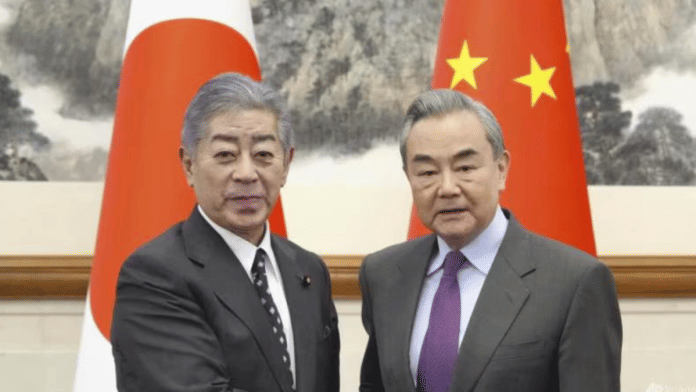Thank you dear subscribers, we are overwhelmed with your response.
Your Turn is a unique section from ThePrint featuring points of view from its subscribers. If you are a subscriber, have a point of view, please send it to us. If not, do subscribe here: https://theprint.in/subscribe/
Building on the spirit of the mid-November meeting between the Chinese President Xi Jingping and Japanese PM Shigeru Ishiba at the APEC economic leaders’ meet in Lima, Peru, the foreign minister of Japan Takeshi Iwaya visited China last week. This was Iwaya’s first visit to Beijing after taking over as Tokyo’s top diplomat in September this year.
The visit comes after a tense relationship between the two countries in recent years. Minister Iwaya held hours long conversations with his counterpart Wang Yi and Chinese premier, Li Qiang. The premier expressed cautious optimism by saying that the ties were at “a critical period of improvement and development”.
Meanwhile, the Japanese foreign ministry said that the FM expressed serious concerns regarding increasing Chinese military activity in the East China sea near Senkaku islands (referred to as Diaoyu islands by China). Japan protested strongly in August when Chinese military aircraft intruded its airspace. Iwaya, a security expert also discussed the issue of Japanese nationals detained in China on spying allegations.
Discussions were also held regarding Chinese trade restrictions on Japanese seafood after Tokyo Electric power company (TEPCO) discharged what it claimed was water treated and diluted to a much safer levels than the international standards from the Fukushima nuclear power plant last year. Chinese experts joined an IAEA mission in October last year to collect water samples from the coast near Fukushima. However, no breakthrough on that front is expected during the visit.
Beyond the Prima facie issues in discussion, one can look at the bigger shifts in the region. Firstly, the upcoming presidency of Donald Trump in the US. When Trump won the elections for the first time in 2016, the then PM of Japan, Shinzo Abe was the only major foreign dignitary to have met Trump at his resort in Florida before his inauguration in 2017. This month he did host Akie Abe, the slain PM’s wife, at Mar-a Lago but hasn’t made any headline grabbing statements on Japan. This time however, after his election victory and before his inauguration he has met the Canadian PM & the Argentinian president at his Florida resort and has travelled to France for the reopening of the Notre-Dame Cathedral where he met the president of Ukraine along with the president of France. Along with that there is the invitation extended by Trump to the Chinese president for his inauguration and the speculation around it. The Japanese political instability might have something to do with this but as elsewhere a Trump administration might be retracting on certain security overtures in east Asia too.
Even China is adapting to the political change in the US and building bridges with US’s partners in the region. The agreement with India in October on LAC disengagement is seen by many in the same light. As the threat of tariffs loom on an already milder Chinese economy, this détente with India comes after the economic survey in India recommended a relook at restrictions on Chinese investment. Tariffs have been imposed on EVs manufactured in China, not just by the US but also by the EU. To offset the same China has looked up to Australia which hasn’t followed the tariff onslaught on Chinese EVs.
Finally, the political instability in South Korea starting with the imposition of martial law on December 3, this year must be considered as well. Former president Yoon Suk Yoel pioneered a rapprochement towards Japan during his term. He became the first South Korean president to travel to China in 12 years to mend the relations between the two countries which were battered during his predecessor Moon Jae-in’s term due to a 2018 court ruling in South Korea against Japanese companies for using forced Korean labour during World War II. As of now not just Yoon but the acting president from People Power Party of South Korea Han Duck-Soo has been impeached while the democratic party of former President Moon holds the majority in the single chambered National assembly of South Korea.
With a history of Donald Trump directly dealing with North Korea without taking the surrounding, especially Japan’s, concerns into consideration, Japan might be exploring its options. A strong triangular relationship between Japan, South Koea and the United States developed during President Yoon and President Biden’s time may suffer some strains in the future. The dynamics within China, Japan and the US will be looked more closely. Partisan relations are not just unique to South Asia.
These pieces are being published as they have been received – they have not been edited/fact-checked by ThePrint.


